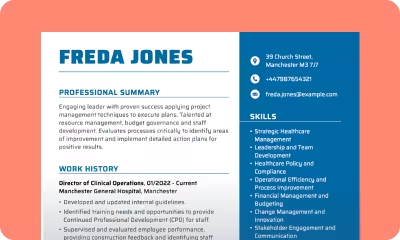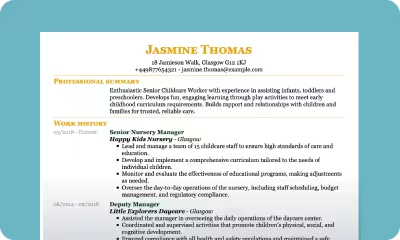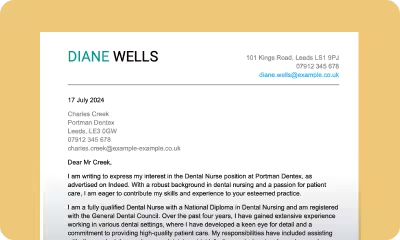- Our customers have been hired by : *Foot Note
To gain employment in the manufacturing and fabrication sectors you will need to write CV that accurately reflects your professional skills and other abilities in the workplace. As well as highlighting your strengths, it should be laid out in an appropriate format that makes it easy for employers to understand at a glance.
We advise reading through some CV examples before implementing the advice below. Our fabricator welder CV sample constitutes an invaluable tool for job seekers and will help to make sure that you include everything you need as well as offer many other insights.
On top of this, we recommend choosing a pre-made CV template to showcase your most irresistible qualities. Pick a blueprint, fill in the sections using the following tips, and save the document as a Word or PDF file. Ready to learn more? Let’s run through:
SEARCH ALL CV EXAMPLES
Sample fabricator welder CV
Dom Webster
46 Roman Rd
Leeds LS2 3ZR
07912345678
dom.webster@example.co.uk
Professional summary
Motivated welding and fabrication professional with experience fitting, setting and installing large structures. Works productively to complete fabrications to detailed engineering specifications. Operated varied machinery and equipment to provide reliable, adaptable construction support.
Work history
January 2021 – Current
Welders & Co – Leeds
Fabricator Welder
- Measured component pieces and checked values against task specifications.
- Fabricated component pieces and built structures from start to finished product.
- Safely operated heavy machinery to perform operations to highest standards.
February 2019 – December 2020
Welders UK – Cromer
Trainee Welder
- Gained experience with spot welds and working with manual metal arc equipment.
- Planned future works with the senior welder to ensure all jobs were delivered on time.
- Undertook training in first aid and emergency evacuation procedures.
Skills
- Steel fabrication
- MIG welding
- Welding repairs
- Quality inspections
- Metallurgy
- Piranha iron work
- Manual dexterity
- Project Management
Education
2018
Leeds College Leeds
NVQ Level 2 Diploma in Fabrication, Engineering, and Welding
Choosing the right format for your fabricator welder CV
You might be the best writer in the world, but it doesn’t matter if you fail to present information in an easy-to-read and eye-catching manner. That’s where CV formats can help – these professional layouts organise content using bold headings, defined sections, and logical flows.
Choosing the correct format is crucial to success. Busy hiring managers don’t have the time to unravel pages of messy text. Plus, most organisations use CV-scanning software that prefers either a reverse-chronological or a skills-based layout. The former highlights work history, starting from your current or most recent role, while the latter prioritises transferable skills like “health and safety”.
Which is best for a fabricator welder? We advise using a reverse-chronological format because hiring managers prefer candidates with experience. You can discuss part-time, contract, temporary, voluntary, and apprenticeship positions alongside full-time employment.
There’s no need to use a skills-based CV here because you’ll unlikely walk into a fabricator welder career without any work experience. Candidates must complete an apprenticeship or on-the-job training as part of a course, which can be discussed in a reverse-chronological structure.
Additionally, ensure your fabricator welder CV is readable. This means typing in a polished font like Helvetica, Calibri, or Arial, leaving enough space between CV sections, and using digestible bullet point lists. You’ll score extra brownie points for making the recruiter’s life easier!
How to write a CV for a fabricator welder
If you want to write a fabricator welder CV that charges ahead of the competition, you’re in luck. The following sections explain how to write a CV, covering contact details, work experience, education, and more. Plus, we’ll answer your most common CV writing questions. Keep reading as we explain:
- Adding contact details to your fabricator welder CV
- Start your fabricator welder CV with a personal statement
- How to present your work history on a fabricator welder CV
- Top skills for your fabricator welder CV
- How to add education to your fabricator welder CV
Adding contact details to your fabricator welder CV
The first thing you should do when creating your CV is to underscore your most current contact information. We suggest noting it at the top of the page, preferably in a slightly larger or bolder font. Only include the best phone number to reach you on – whether home or mobile – and ensure your email address is work-appropriate. Remember to include:
- Your name
- Location
- Phone number
- Email address
Example of contact section for a fabricator welder CV
Jane Palmer-Moore,
15 Any Road,
Anywhere,
Anycounty, AN29 JDO,
07845 987654321,
janepalmer-m@anyemail.com
Start your fabricator welder CV with a personal statement
Your personal statement is the first thing an employer reads when opening your application. You must spark the reader’s interest in three to four short sentences by summarising your wealth of experience, proudest achievements, and unique skills. While it might sound impossible, we have a handy formula that breaks it down step by step.
Sentence one is an introduction – explain who you are, including years of experience and career focus. Sentence two is the perfect place to drop a jaw-dropping statistic. The final sentence(s) should reiterate your skills and areas of expertise, underscoring why you’re the best candidate for the job.
The jaw-dropping statistic is essential because it backs up your claims. For instance, you might have “enforced safety standards, resulting in a 92% decrease in workplace accidents”. Or “completed a multi-million-pound project eight months ahead of schedule”.
Need some more guidance? Other tips and tricks include:
- Write in the third person to sound more professional
- Include positive adjectives like “eager” and “meticulous”
- Avoid jokes – it might be okay on site, but not in a CV
- Keep the information relevant to the job you’re applying for
- Double-check your work for spelling mistakes
Example of personal statement for a fabricator welder CV
A qualified fabrication welder with a great deal of knowledge of safety systems and operating welding equipment in workshops and manufacturing facilities. Possesses plenty of experience working for fabrication companies. Well-versed in welding to schematics and plans, including interpreting many architectural drawings.
OR
A recently qualified fabricator welder searching for growth opportunities. Experienced in making inspections and test cuts of finished products. Able to work independently or as part of a team. Capable of operating semi-automatic spot-welding equipment and knowledgeable with oxyacetylene and tungsten inert gas welding equipment.
How to present your work history on a fabricator welder CV
The work history section is arguably the most important part of your fabricator welder CV. Employers often spend the most time here, unpicking your strengths, weaknesses, and potential. Plus, they can see how long you typically stay with an organisation – a key consideration for hiring managers who value loyalty.
We suggest taking your time. After all, you want to present your primary responsibilities in the best possible light. Run through:
- Job title
- Employment start and end dates
- Company name
- Company location
- Short list of responsibilities
- Notable accomplishments
How many duties should you include? You don’t want to overwhelm the reader, so we recommend between three to six – three for less-relevant positions and around six for job-specific ones. In addition, be mindful of repetition. If you mention “liaising with customers” underneath one role, talk about “cutting materials” in another. Variety shows the recruiter the scope of your abilities!
Like the personal statement, it’s a good idea to qualify your responsibilities with real-world results. Alternatively, you can mention career achievements, like awards, promotions, and reviews. It’s far more effective to show the employer how amazing you are rather than asking them to believe you.
Lastly, the more confident you sound, the better – you don’t want to put the hiring manager to sleep! Centre unique positive adjectives that capture your personality, and lead with energetic action verbs. Some of our favourites include “engineered”, “developed”, and “delivered”.
Example of work experience for a fabricator welder CV
Fabricator Welder | Welders & Co, Great Yarmouth | June 2018 – Present
- Planning and expediting all welding fabrication jobs in a small company of four employees.
- Ensuring all welding practices are conducted according to the latest health & safety regulations.
- Liaising with customers directly post-sale to ensure fabricated gates and railings are fitted properly.
Trainee Welder | Welders UK, Cromer | January 2015 – May 2018
- Gained experience with spot welds and working with manual metal arc equipment.
- Planned future works with the senior welder to ensure all jobs were delivered on time.
- Undertook training in first aid and emergency evacuation procedures.
Top skills for your fabricator welder CV
Want to impress decision-makers and secure an interview spot? Include a blend of your best CV skills. These keywords quickly reassure employers that you’re qualified for the position. Plus, the scannable format makes it easier for CV-reading software to pick out and pass on your top talents.
Include up to 12 abilities in total, split between hard skills and soft skills. The former are job-specific and technical, often learnt on the job or via formal education – think “welding, sawing and shearing metal sheets”, “interpreting blueprints”, and “inspecting work for defects”. The latter are transferable and personality-based, such as “organised”, “goal-oriented”, and “adaptable”.
Both are equally important because recruiters want to know you have the right knowledge and character for the role. Someone might be the most experienced welder in the world but an awful team player, or a lovable personality with no clue! Ultimately, you’re trying to find the middle ground.
If you need some more ideas, take a look at the following lists:
Essential skills for a fabricator welder
- Level 1 Award in Introductory Welding Skills
- Level 2 Certificate in Welding Skills
- SEMTA registered
- Driving license
- Health and safety knowledge
Desirable aptitudes to set you apart
- Able to lay out materials to be cut or joined in the best order for efficient working, even in tight working spaces.
- Experienced in selecting the most suitable welding method for the job’s requirements.
- Great hand-to-eye coordination and the ability to work accurately under time constraints.
- Excellent problem-solving skills in fast-paced environments.
- Keen attention to detail regardless of project size.
How to add education to your fabricator welder CV
Education sets you apart from equally experienced candidates, especially in a highly competitive field like fabrication welding. You can discuss extracurricular training, certificates, and refresher courses alongside college and university qualifications.
Is it difficult to become a fabricator welder? Many applicants begin with a college course to gain fundamental theoretical knowledge and practical tools. Alternatively, you can complete a Level 1, Level 2, or Level 3 City & Guilds course in Welding Skills.
Although qualifications set you apart, they aren’t essential. The most important thing is to cinch a fabrication apprenticeship, which requires a good level of English and Maths.
When outlining your education, list:
- Name of school, college, university, or other awarding body
- Study start and end dates
- Subject title
- Qualification level – e.g. NVQ or GCSE
- Qualification result
Example of education for a fabricator welder CV
Any College | September 2004 to September 2006
Level 2 (NVQ) Diploma in Fabrication, Engineering, and Welding
Any High School | September 2002 – September 2004
AS levels: Technology (B) and Physics (C)
Any High School | September 1997 – September 2002
GCSEs at grades B – D in English, Maths, Science, Technology, and Geography
Top dos and don’ts for fabricator welder CV writing
Do
Do highlight your apprenticeships
To become a fabricator welder, you would’ve had to complete at least one apprenticeship – this is just as important as traditional full-time employment, so treat it the same in the work history section. Outline your key responsibilities, sneak in a few showstopping statistics, and underline any notable achievements.
Do note areas of expertise
Fabrication is an umbrella career with many niches and areas of expertise. Consequently, outline your specialisms in your personal statement to give the employer a better idea of your strengths. Specialist skills are one way to stay competitive, so they’re worth shouting about if you have them!
Don’t
Don’t forget to attach a cover letter
An introductory cover letter is a concise one-page document that explains why you’re applying for the position, summarises your top traits, and gives the employer a better idea of interview availability and start dates. Our top tip? Don’t rehash the content in your CV – try to include brand-new information and figures.
Don’t send your application without spell-checking
A tidy and legible fabricator welder CV guarantees to catch the hiring manager’s eye. Run your work through a free spell-checker and ask a friend, family member, or trusted colleague for feedback. A fresh pair of eyes can often wheedle out repetitiveness and not-so-obvious mistakes.
Your fabricator welder CV questions answered
What is fabrication?
Fabrication is the process of turning raw materials – typically metal – into finished components, including electrical equipment, household objects, toys, and more. A fabricator might produce single parts for a product or every element. The complex work occurs in factories, specialist shops, and construction sites.
What does a fabricator welder do?
The day-to-day duties of a fabricator welder depend on the project and place of work. However, there are a few crossovers, including:
- Creating metal components for products
- Interpreting engineering plans, drawings and instructions
- Overseeing the best health and safety practices
- Confidently using various power tools
- Using computer software to design structures
What skills do welders need?
Welders need a wealth of hard and soft skills to excel in their position. We’ve mentioned many of the hard skills above, so let’s explore the latter:
- Ability to work within tight deadlines
- Enthusiastic learner and team player
- A knack for mathematics and engineering
- Keen attention to detail
- Excellent communicator
How much does a welder make?
How much welders make depends on experience and location. However, most welders in the UK can expect somewhere between £25,000 to £35,000 per year. Of course, this increases as you gain more specialist skills or take on extra responsibilities, like training team members or overseeing projects.
Create a fabricator welder CV that stands out from the crowd
This fabricator welder CV sample is only a single version of the many examples available which afford key insights into the process of writing a new CV. Anyone seeking a job should also look into our tools and CV builder for additional valuable advice.
Other professional CV examples will give you bundles of ideas on completing each CV section. Or head to the online builder to choose a pre-made CV template that’s ideal for fabricator welder roles. You can then search for related jobs to find content that’s relevant and ready to go for your CV.
*The names and logos of the companies referred to above are all trademarks of their respective holders. Unless specifically stated otherwise, such references are not intended to imply any affiliation or association with myperfectCV.




